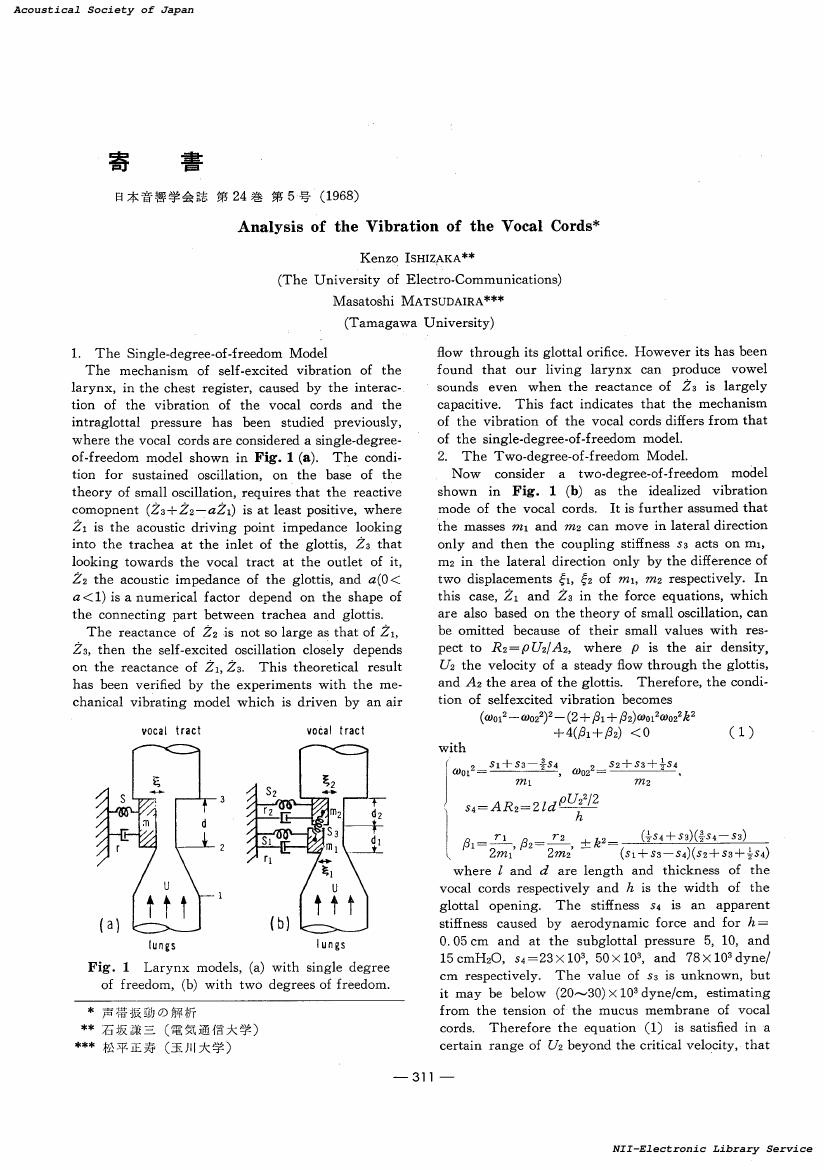2 0 0 0 OA 声帯音源の自励振動モデル
- 著者
- 石坂 謙三 フラナガン ジェームズ L.
- 出版者
- 一般社団法人 日本音響学会
- 雑誌
- 日本音響学会誌 (ISSN:03694232)
- 巻号頁・発行日
- vol.34, no.3, pp.122-131, 1978-03-01 (Released:2017-06-02)
- 被引用文献数
- 4
In earlier work, we derived a dynamic model of vocal-cord vibration, in which a single vocal-cord is described by two mechanical resonators coupled with a stiffness, so-called a two-mass model of the vocal-cords. This simplified model reveals essential features of the self-exciting oscillation mechanism of vocal cord vibration and duplicates the principal features of vocal cord behavior in the human. In the original two-mass model, we estimated that the longitudinal component of vocal cord motion has only secondary influence upon glottal flow and hence upon the self-exciting oscillation mechanism. Therefore, the longitudinal motion has been neglected. We examined the more rigorously earlier estimate. We modifyied the two-mass model for on additional longitudinal motion parallel to the direction of glottal flow. The formulation also involves the rate of air volume displaced by the vibrating masses. Then, computer simulation was carried out on the dynamic twodimensional motion for the vocal cord masses, as shown in Fig. 5. This motion corresponds with the observation made on natural larynxes. According to the results, the longitudinal component of displacement influences oscillation frequency only slightly (less than one Hz) and hardly contributes to the realistic behavior of glottal opening. We therefore conclude that the longitudinal motion is not essential for the realistic self-exciting oscillation of the vocal cords. The dynamic model of vocal cord/vocal tract can generate the synthetic speech with high naturalness. Voice quality and the prosodic features of speech are strongly dependent upon the acoustic properties of glottal excitation sources. The acoustic properties of the glottal flow, U^*_g, and the resulting synthetic vowels /e/ and /a/ are shown in Fig. 6 and 8, respectively. In this self-oscillating model, a conventional assumption of the linear separability of sound source and vocal tract is not made. To indicate the influence of the coupling between them, the acoustic properties of the glottal flow without coupling, U^*_g, and the resulting synthetic vowels are also shown in the figures. Fig. 7 shows the difference in the waveforms of U_g and U^*_g plotted with 10-times enlarged scale. However, the stronger couplinger usually occurs in consonants, in which the constriction in the vocal tract is much smaller than that for vowels, and the vocal-cord behavior can substantially be influenced through the interaction. The vocal-cord model can intrinsically produce the intricacy of natural behavior from relatively simple, physiologically-based parameters ; namely subglottal pressure, rest area of glottal opening, vocal-cord tension, and vocal-tract shapes. Some of these behavior are demonstrated by the examples of the synthesis of vowel-consonant-vowel syllables. Such an example is shown in Fig. 9 for /epa/. Finally, we describe the automatic generation of golttal turbulent noise and glottal stop with the vocal-cord model without any additional control parameter.
1 0 0 0 OA 声帯の自励振動モデルと計算機シミュレーション
- 著者
- 石坂 謙三
- 出版者
- The Japan Society of Logopedics and Phoniatrics
- 雑誌
- 音声言語医学 (ISSN:00302813)
- 巻号頁・発行日
- vol.22, no.3, pp.243-249, 1981-07-25 (Released:2010-06-22)
- 参考文献数
- 17
- 被引用文献数
- 1
This paper discusses models of the vocal cords, which can be categorized into a drivingpoint impedance (or terminal) type and a multi-mass system type. The former typically involves a so-called one-mass model and also a two-mass model of the vocal cords, and the latter represents the difference approximation of motion equations and also the finite element method. Models for the air flow through the larynx are also considered in connection with the models of the vocal cords.The mechanism of self-excited oscillation of the vocal cords is described in terms of the degeneration of natural modes of vibration which results from the glottal flow. The intention is to clarify the distinction between the self-excited oscillation and the free oscillation of the vocal cords.A self-excited oscillator inherently involves some of non-linear factors with respects to the amplitude of oscillation. In the vocal-cord oscillator, they are the collision of the bilateral vocal cords, the non-linear elasticity of cord tissue, and the non-linearity in the aerodynamics. These non-linear factors must properly be involved in the computer models of the vocal cords. Finally, general cosiderations of the computer simulation of cord-vibration are discussed.
1 0 0 0 OA 声帯振動の解析
- 著者
- 石坂 謙三 松平 正寿
- 出版者
- Acoustical Society of Japan
- 雑誌
- 日本音響学会誌 (ISSN:03694232)
- 巻号頁・発行日
- vol.24, no.5, pp.311-312, 1968-09-30 (Released:2017-06-02)
1 0 0 0 OA ベル研究所および王立工科大学・音声通信研究所(スエーデン)
- 著者
- 石坂 謙三
- 出版者
- 一般社団法人 日本音響学会
- 雑誌
- 日本音響学会誌 (ISSN:03694232)
- 巻号頁・発行日
- vol.28, no.8, pp.444-447, 1972-08-01 (Released:2017-06-02)

